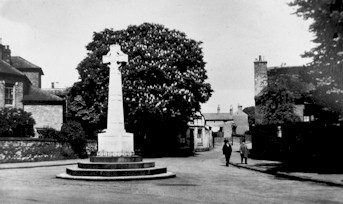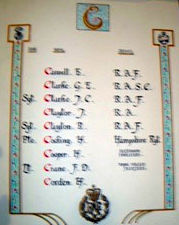| Home Topics Memorials Miscellany Transcripts References Family History Glossary Latest Beeston Blog About us | Site Search |
|
The World War Memorial at Beeston -
Nowadays, perhaps the best known War Memorial in Beeston - and the one used every year for the Act of Remembrance - stands on the bend of Middle Street, near the Manor House and the top of Dovecote Lane. It was originally erected to the memory of the fallen of the Great War (1914-1918) and later extended in remembrance of those who died in World War2 (1939-1945). The memorial was originally erected on the site of the old village cross (see the picture in the page heading), but was moved back slightly when Middle Street was extended to Chilwell Road in the 1960s. The memorial is shown in the picture in its original, rather more gentle, surroundings. Although the need for an appropriate memorial was recognised very soon after the Armistice in November 1918, its form was by no means widely agreed and there was a period during which the divisions of opinion were aired openly. As early as February 1919, a public meeting was called at which a Committee was formed and a decision was made to launch a house-to-house collection. The Committee was to be chaired by Councilor William Herbert George (a Beeston butcher), the Treasurer was Frederick William Poyser (Manager of the London Joint City & Midland Bank, in the Square) and the Joint Secretaries were Arthur Kirkland (previously a lace manufacturer but then Collector of Rates) and Arthur Samuel Page (Assistant to Mr Poyser at the bank). At this stage, there were many suggestions for the form of the memorial, including a public baths (an aspiration that continues to this day), a library, a public hall and a reading room. The committee agreed to pursue the idea of a pleasure garden with a small hall with inscribed tablets listing the fallen. A shilling fund was launched to try to raise the necessary funds. However, criticism of this proposal existed from the beginning and by July 1919 there were already calls for another public meeting. By August, only £36 had been raised towards the proposed hall and gardens which would cost £3,000. Despite a new proposal to limit the scheme to a hall without gardens, there would still be the need to raise £1,500 - widely thought to be an impossible sum at a time when incomes were tight. Meanwhile, another scheme to provide a memorial in the Parish Church, in the form of five bronze tablets, inscribed with the names of the fallen, to be erected in the organ arch, was going relatively well, with over £269 already subscribed against the £500-600 that would be needed. A month later receipts had reached £300 and continued to come in. By April 1920, the Committee was forced to accept reality and to abandon the memorial hall proposal and decided that a Memorial Cross should be erected in a suitable spot. By June,1920 Louis Pearson, the energetic Chairman of Beeston Foundry who had recently been awarded the CBE for his role as Chairman of the Nottingham Munitions Board of Management, had been appointed Chairman of the Memorial Committee and progress was soon apparent. The Cross at the junction of Church Street and Middle Street was selected as the proposed site for the memorial and, by July, Nottingham-based architect, William Herbert Higginbottom's design had been accepted - a Celtic cross in Portland stone, a replica of that on the Island of Iona, standing 19 feet in height on an octagonal base of three steps. A drawing of the proposed cross was displayed in the window of the London Joint City & Midland Bank, in the Square and appeared in the Beeston Gazette & Echo. At this stage, a total cost of £350 was estimated and £200 had already been raised. It was agreed that work should start when £275 was reached. Fund raising continued over the next year with detailed planning progressing in the background - although there was still a degree of dissent from some sections of the public who favored alternative forms of memorial - a dental clinic was one suggestion that was then being suggested, However, by the end of 1919 collections had grown to over £450, reflecting the expected increase in the overall cost of the memorial. The delay had also meant that the Remembrance Day Service had to be held near to the Boer War Memorial in The Square and this was also the case on November 1920. On April 3 1921, the memorial screen in the Parish Church was dedicated by the Archdeacon of Nottingham and unveiled by Col. Sir Dennis R Bayley. On it were inscribed the names of 270 Beeston-related war-dead from the Great War. The cost of the memorial had reached around £650, mainly because of a decision to use better quality inscriptions and to include rank and regiment with the names. Some of this amount had still to be raised at the time of the memorial's dedication but was eventually cleared. The names on this memorial were used as the basis of the memorial page on this site. At the same time, the erection of the memorial cross was well underway and, on 21 May 1921 it was unveiled by Colonel Sir Launcelot Rolleston KCB, DSO supported by the Louis Pearson,
Chairman of the War Memorial Committee and a large number of dignitaries, clergy and representatives of local organisations. Colonel Rolleston paid a moving tribute to the 270 local men who had
given their lives and were now commemorated, to those left behind and those who had been spared to return. Together, they had made it possible to live in a land of liberty. It was a very emotional
occasion, particularly for those who had lost loved ones. Many laid wreathes were on the base of memorial at the time although several grieving relatives waiting to do so in a later, more private
time. Reflecting the intensity of this grief and feeling, the Beeston Gazette and Echo were moved to suggest, in an editorial, that the memorial was a sacred place and parents should ensure
that their children do not play on the steps. The inscriptions on the memorial read: By their Valour and the grace of God, they Won
In the following November, the memorial became the focus, for the first time, of the annual Remembrance Day Ceremony and Silence and has taken that important role every year since. By the following January the Treasurer was able to report that the final few pounds had been raised and he was able to present the final balance sheet showing that the cost of erecting the memorial, by the local contractor Pask & Thorpe, had been £440; the architect's fee was £25, curbing work had cost £19 and other expenses had made the total of £509. Donations and fund raising had raised £494 and bank interest of £15 had covered the balance. Following the Second World War, the memorial was further dedicated to the dead of that war and the words 'World War 1939-1945' were added. A renovation of the memorial was carried out in 2009. In about 1990, a Roll of Honour in the form of a book with names inscribed in its pages, listing local people who died in that war and in other subsequent conflicts, was place in the Parish Church. It was designed and written by Disney Keeble in conjunction with the local branch of the British Legion. A typical page is shown right. The names, which include those from the wider Beeston area, have recently been transcribed by Jane Eden and we hope to make them available here in due course. |
|
||||||||
|
|
||||||||||

 Names of the fallen had not been included in the inscription, those names being included in the memorial panels in the Parish Church.
Names of the fallen had not been included in the inscription, those names being included in the memorial panels in the Parish Church.